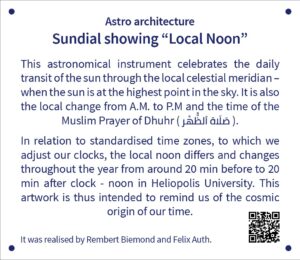1) Local Noon or A.M. P.M. is an art piece.
It was co-created by two people in the Heliopolis University Network. Felix Auth (Chief Building Developer HU) and Rembert Biemond (Board of Trustees HU, board member SEKEM Holding) co-created together with the piece in a couple of on-site meetings and many online chats.
Both do not consider themselves professional Artists, but both consider themselves artists along the lines of the exclamation mark of Joseph Beuys, the German artist whose 100th birthday is celebrated in 2021 who redefined art with the slogan: “Jedermann ein Künstler! Which translates roughly as “Everybody [should be] a creator!” – A slogan which as well could serve as a claim of HU and its core program itself.
2) Local Noon an astronomical instrument celebrating the daily transit of the Sun from A.M. to P.M.
During more than 100 centuries true noon, or local noon, when the sun reaches its highest point for the day, transiting over the local Meridian, which is the North-South line at any location, was considered the middle of the day or Noon. 12:00 in digital number if you wish.
A.M. stands for Latin “Anti Meridian” which means before, while P.M. wrote out reads “Post Meridian”, meaning after the Meridian.
In our regulated time-zoned world local noon is no longer the key parameter. But the invention of a regulated time and time zones is just some 200 years old. When trains started the need for a regulated time was born. And that is what we now have on our clocks, watches, and phones. Local noon differs from 12:00 on our clock. It moves over the year. In Heliopolis between around 20 minutes before and after the clock-noon.
Religions kept the cosmic rhythms. True-local-noon, not clock-noon remains the point of orientation and consideration for the midday prayer in Islam. And similar other cosmic rhythms like sunrise, sunset, first new moon, etc. remain cornerstones of the cosmic-earthly relationship celebrated in rituals across religions over the globe.
The piece is intended to remind us of the cosmic origin of our time.

3) The art piece serves also as a calendar.
The point where the sun is projected on the local meridian scale of the piece – at local noon- changes over the year. In winter when the sun is lower the light dot-projecting the sun is higher up. In June when the sun is highest the lower end of the scale is reached.
4) The Heliopolis University Meridian
The piece also celebrates the local Heliopolis Meridian. In GPS times where even our phones track our global position in numbers every couple of seconds, we define our position with Greenwich as the point zero. And we record our longitude in Grades, Minutes, and Seconds in relation to that Meridian crossing the Royal Observatory in London. The Heliopolis Campus is some 31 Degrees East of Greenwich.
But that this was standardized is also just some 140 years old. As Great Britain was dominating the seas at that time the naval charts which used the London (Greenwich) Meridian as a reference became popular. Aviation and other uses followed.
But local Meridians should be celebrated and honored as much as local noon and local food. Famous universities in the past all had their local Meridian. It will be a nice exploration to see which other locations this Meridian touches.
5) Astro-Architecture
Ibrahim Abouleish, Founder of the Heliopolis University was during the last year of his life excited to have elements of Astro-Architecture on Campus and at other SEKEM locations. He was a strong advocate that future buildings on Campus should have Astronomical References. He was excited about the works of James Turrell. The potential making of this piece was discussed with him on several occasions during the last year before he passed away in 2017.
6) Sustainability
The HU has the sustainability claim in its subtitle. The piece wants to remind us that true sustainability is counted beyond generations and should be seen in astronomical and geological timeframes.
On the occasion of the opening of the piece and the 84 birthday of Ibrahim Abouleish
And with the hope that the piece “Local Noon” will become a well-visited spot and time on the HU Campus.
Rembert Biemond
March 21st – 23nd, 2021
